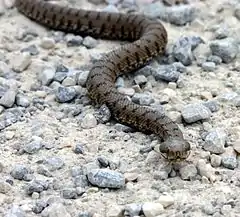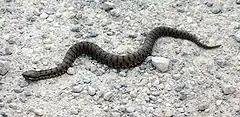Vipera aspis francisciredi
Vipera aspis francisciredi is a venomous subspecies of the European asp[3] endemic to northern and central Italy and adjacent Croatia, Slovenia, and Switzerland.[4]
| Vipera aspis francisciredi | |
|---|---|
 | |
| Scientific classification | |
| Domain: | Eukaryota |
| Kingdom: | Animalia |
| Phylum: | Chordata |
| Class: | Reptilia |
| Order: | Squamata |
| Suborder: | Serpentes |
| Family: | Viperidae |
| Genus: | Vipera |
| Species: | |
| Subspecies: | V. a. francisciredi |
| Trinomial name | |
| Vipera aspis francisciredi Laurenti, 1768 | |
| Synonyms[1] | |
| |
- Common names: Central Italian asp.[2]
Etymology
The subspecific name, francisciredi, is in honor of Francesco Redi, an Italian physician who was a pioneer in experimental toxinology.
Description
The head is distinctly swollen behind the eyes and upper lips; in adults, this feature is clearly visible when viewed from above.[4]
Regarding the color pattern, many examples of this subspecies have a white or cream-colored spot near the outer edge of each ventral scale; these spots are smaller in V. a. aspis (if at all present), but much more apparent in V. a. francisciredi.[4]
Geographic range
Street (1979) describes this subspecies as inhabiting most of Italy, where it is the most common and widely distributed venomous snake. It also occurs in the Swiss canton of Ticino, south of the Monte Ceneri Pass, but is not found west of nearby Lake Maggiore. Also in the north, in Trentino-Alto Adige/Südtirol, it can be found as far north as Meran, but is not found in Austria, and as far east as Gorizia (on the border with Slovenia). In the south of Italy, it is absent from Basilicata and Calabria.[5]
In the former Yugoslavia, it is a rare inhabitant of the Julian Alps (Pozzi, 1966). There have been reports of specimens from Ripanj near Belgrade, Jahorin in Bosnia and other parts of "Yugoslavia", but some of these may have been confused with V. berus bosniensis.[5] Nevertheless, the European Molecular Biology Laboratory (EMBL) describes the range of this subspecies as stretching from southern Switzerland, northern and central Italy, to Slovenia and northwestern Croatia.[6]
The type locality listed by Laurenti (1768) for Vipera Francisci Redi (= V. a. francisciredi) is "Austriaco & Italico" (= Austria and Italy).[1]
Conservation status
The whole species is classified as Least Concern (LC) according to the IUCN Red List of Threatened Species (v3.1, 2008).[7] This subspecies is however considered Endangered (EN) in Switzerland[8] due to its very limited occupation area.
References
- McDiarmid RW, Campbell JA, Touré T. 1999. Snake Species of the World: A Taxonomic and Geographic Reference, Volume 1. Herpetologists' League. 511 pp. ISBN 1-893777-00-6 (series). ISBN 1-893777-01-4 (volume).
- Mehrtens JM. 1987. Living Snakes of the World in Color. New York: Sterling Publishers. 480 pp. ISBN 0-8069-6460-X.
- "Vipera aspis francisciredi". Integrated Taxonomic Information System. Retrieved 15 August 2006.
- Mallow D, Ludwig D, Nilson G. 2003. True Vipers: Natural History and Toxinology of Old World Vipers. Malabar, Florida: Krieger Publishing Company, Malabar. 359 pp. ISBN 0-89464-877-2.
- Street D. 1979. The Reptiles of Northern and Central Europe. London: B.T. Batsford Ltd. 268 pp. ISBN 0-7134-1374-3.
- Vipera aspis at the Reptarium.cz Reptile Database. Accessed 12 December 2007.
- Vipera aspis at IUCN Red List. Accessed 31 July 2020.
- OFEFP red list. Accessed 31 July 2020.
Further reading
- Laurenti JN. 1768. Specimen medicum, exhibens synopsin reptilium emendatam cum experimentis circa venena et antidota reptilium austriacorum. Vienna: "Joan. Thom. Nob. de Trattnern". 214 pp. + Plates I.- V. ("Vipera Francisci Redi", pp. 99–100, 198-201).
- Pozzi A. 1966. Geonemia e catalogo ragionato degli Anfibi e Rettili della Jugoslavia. Natura, Milan 51 (1): 1-55.

